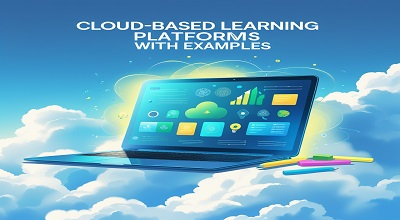Cloud-Based Learning Platforms
Cloud-Based Learning Platforms: Cloud-based learning platforms are online educational systems that leverage cloud computing to deliver courses, training, and learning resources. These platforms enable students, educators, and institutions to access content anytime, anywhere, without needing physical infrastructure.
With advancements in technology, cloud-based learning has become a cornerstone of modern education, offering flexibility, scalability, and cost-efficiency. From K-12 schools to corporate training, these platforms are transforming how knowledge is shared and consumed.
Benefits of Cloud-Based Learning Platforms
Accessibility and Flexibility
- Learners can access materials from any device with an internet connection.
- Supports self-paced learning.
Cost-Effectiveness
- Reduces the need for physical textbooks and infrastructure.
- Subscription-based models lower upfront costs.
Scalability
- Accommodates thousands of users simultaneously.
- Easy to update and expand course offerings.
Collaboration and Engagement
- Features like discussion forums, live classes, and group projects enhance interaction.
- Real-time feedback and assessments.
Data Security and Backup
- Cloud storage ensures data is secure and recoverable.
- Automatic updates and backups reduce IT burdens.
Top Cloud-Based Learning Platforms in 2024
Here are some of the leading cloud-based learning platforms currently shaping education:
Google Classroom
- Features: Integrates with Google Workspace, assignment distribution, grading.
- Best For: K-12 and higher education.
Microsoft Teams for Education
- Features: Virtual classrooms, collaborative documents, integration with Office 365.
- Best For: Schools and universities.
Canvas by Instructure
- Features: Customizable LMS, mobile-friendly, third-party app integrations.
- Best For: Higher education and corporate training.
Blackboard Learn
- Features: AI-driven analytics, discussion boards, multimedia support.
- Best For: Universities and large institutions.
MoodleCloud
- Features: Open-source, customizable, gamification.
- Best For: Small to mid-sized schools and businesses.
Coursera
- Features: University-backed courses, certifications, degree programs.
- Best For: Professional and higher education.
Udemy Business
- Features: Thousands of courses, skill assessments, analytics.
- Best For: Corporate training.
Khan Academy
- Features: Free courses, interactive exercises, progress tracking.
- Best For: K-12 and self-learners.
Edmodo
- Features: Social learning, parent-teacher communication, quizzes.
- Best For: Schools and teachers.
Zoom for Education
- Features: Virtual classrooms, breakout rooms, webinar hosting.
- Best For: Live online learning.
How Cloud-Based Learning Enhances Education?
Personalized Learning
- AI-driven recommendations tailor content to individual needs.
- Adaptive learning paths improve engagement.
Global Reach
- Breaks geographical barriers, allowing international collaboration.
- Supports multilingual education.
Blended Learning Models
- Combines online and in-person instruction.
- Flipped classrooms enhance student participation.
Real-Time Analytics
- Tracks student performance and identifies learning gaps.
- Helps educators refine teaching strategies.
Challenges and Solutions in Cloud-Based Learning
Internet Dependency
- Solution: Offline access modes and low-bandwidth optimizations.
Data Privacy Concerns
- Solution: Strong encryption and compliance with GDPR/COPPA.
Resistance to Change
- Solution: Teacher training and gradual implementation.
Technical Issues
- Solution: 24/7 support and user-friendly interfaces.
Future Trends in Cloud-Based Learning
AI and Machine Learning Integration
- Smart tutors, automated grading, and predictive analytics.
Virtual and Augmented Reality (VR/AR)
- Immersive learning experiences in science, history, and vocational training.
Blockchain for Credentialing
- Secure digital certificates and tamper-proof academic records.
5G and Faster Connectivity
- Enables seamless streaming and real-time collaboration.
Conclusion
Cloud-based learning platforms are revolutionizing education by making it more accessible, interactive, and efficient. As technology evolves, these platforms will continue to integrate AI, VR, and other innovations to enhance learning experiences. Institutions and educators must embrace these tools to stay ahead in the digital education landscape.
FAQs
Q1: What is a cloud-based learning platform?
A cloud-based learning platform is an online system that delivers educational content via cloud computing, allowing users to access courses and resources from anywhere.
Q2: Are cloud-based learning platforms secure?
Yes, most platforms use encryption and comply with data protection laws to ensure security.
Q3: Can cloud-based learning replace traditional classrooms?
While they enhance education, a blended approach combining online and in-person learning is often most effective.
Q4: How much do these platforms cost?
Costs vary—some are free (like Khan Academy), while others have subscription models (like Coursera or Udemy Business).
Q5: What is the best cloud-based learning platform for schools?
Google Classroom and Microsoft Teams for Education are popular for K-12, while Canvas and Blackboard are widely used in higher education.
Free Here: Battlefield Mobile APK
